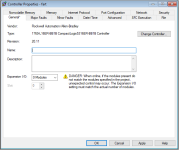Hi Group
Hope everyone is ...not too shabby.
I developed a program using RSLogix 500 for use on a MicroLogix 1400.
I need to update to a newer platform using essentially the same program (with whatever mods might be needed to suit the new PLC). (Hoping to keep the mod work to a minimum)
Looking for recommendations as to which PLC.
PLC requirements:
12 relay outputs
4 DC inputs
4 RTD analog inputs
1 4-20 mA analog input
1 port for HMI, 1 port for RS-232 serial ASCII interface to a printer
The program has (along with the basics) the following instructions in it which are a must but may not be usable on some lower end PLCs:
AWT (ASCII Write) for sending data to the printer
ACN (ASCII Concatenate) so i can assemble an ASCII string before sending to the printer
SCP (Scale With Parameters) for the analog inputs
I have RSLogix 500 and RSLogix 5000
The PLC and any added modules need to be as small as humanly possible. Esp. the length of the overall assembly) This is also extremely important.
I am using an Automation Direct HMI which I plan to keep using.
Any suggestions would be very much appreciated. Thanks in advance!
Hope everyone is ...not too shabby.
I developed a program using RSLogix 500 for use on a MicroLogix 1400.
I need to update to a newer platform using essentially the same program (with whatever mods might be needed to suit the new PLC). (Hoping to keep the mod work to a minimum)
Looking for recommendations as to which PLC.
PLC requirements:
12 relay outputs
4 DC inputs
4 RTD analog inputs
1 4-20 mA analog input
1 port for HMI, 1 port for RS-232 serial ASCII interface to a printer
The program has (along with the basics) the following instructions in it which are a must but may not be usable on some lower end PLCs:
AWT (ASCII Write) for sending data to the printer
ACN (ASCII Concatenate) so i can assemble an ASCII string before sending to the printer
SCP (Scale With Parameters) for the analog inputs
I have RSLogix 500 and RSLogix 5000
The PLC and any added modules need to be as small as humanly possible. Esp. the length of the overall assembly) This is also extremely important.
I am using an Automation Direct HMI which I plan to keep using.
Any suggestions would be very much appreciated. Thanks in advance!
Last edited:








